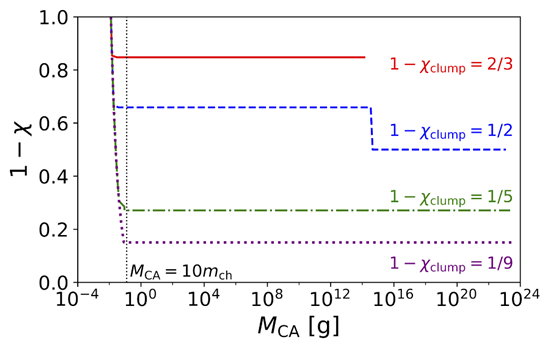Research Gallery > The Theoretical Astrophysics (Theory)
Research Gallery
The Theoretical Astrophysics (Theory)
| Meteorites as a clue to the physical environment in the Solar System |
|
Image Credit: Matsumoto et al.

The evolution of the chondrules fraction in a chondrite parent body (1-χ) as the function of its mass (MCA) calculated by Matsumoto et al. (submitted). The vertical dotted line shows the chondrite parent body mass when it is equal to ten times chondrule mass. The different lines show the different chondrule fraction in dense clumps (1-χclump).
|
| We are also carrying out studies of meteorites that give us clue to the physical environment in which the Solar System bodies are formed. Most of the meteorites are chondrites, which include ~mm size spherules called chondrules. Chondrules are covered by ~μm - ~nm sized matrix grains. Chondrite parent bodies are considered as the remnants or fragments of planetesimals. The isotope measurements of chondrules suggest that their natal places are high density clumps. Matsumoto et al. (submitted) consider the evolution of chondrules and matrix grains in such clumps. In dense clumps, aggregates composed by matrix and those by chondrules and matrix grow up due to short collision timescales. Our results suggest that chondrules are inhomogeneously distributed in the chondrite parent bodies formed in such clumps. |
 asiaa.sinica.edu.tw Media Request: epo
asiaa.sinica.edu.tw Media Request: epo asiaa.sinica.edu.tw
asiaa.sinica.edu.tw 
